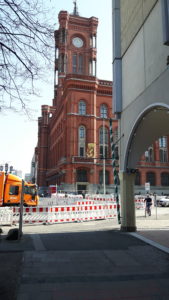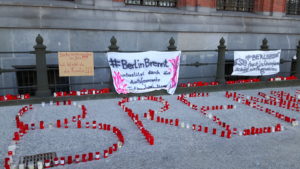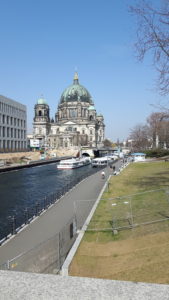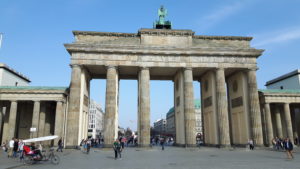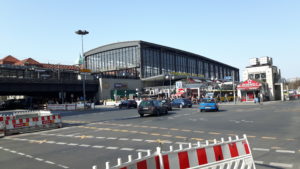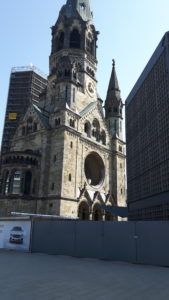“Mein Koffer in Berlin” – Part One: Refreshing memories of 1990s and walking around
“Ich habe noch einen Koffer in Berlin” (I still have a piece of luggage in Berlin) – this is the way that old Berliners express their longing for getting back to the home town they have left behind. The first one (if remember correctly) to record the song was Marlene Dietrich, and many others have done it after her. I am not a singer but I share this feeling although my time in Berlin was relatively short – from June 1994 to September 1995. But that was long enough to get familiar with the mega-city consisting of different kinds of districts (Bezirken) that had once been independent municipalities. And the history of Berlin (East and West) has left its traces, as well as the unification and the rebuilding and remodelling of the capital of the unified Germany. So, now that I had a chance to spend three days in Berlin, I got back to my luggage of memories just like Marlene Dietrich in her song.
Walking in Berlin – the sights “um de Ecke” (round ‘e corner) in East Berlin
To me, walking in Berlin was an endless series of expeditions in different parts of Berlin in the years 1994 – 1995. At that time I was working as a national seconded expert at Cedefop (European centre for the development of vocational training) – during that last year and a half before the centre was relocated to Thessaloniki, Greece. But this is not a story of my work but of my memories of Berlin. So, I kept visiting firstly the centres of West Berlin and East Berlin – the divide into two was still there and the construction sites in the border zones were only taking shape. And with the tube (U-Bahn) I travelled to all surrounding districts and collected impressions. So, I learned to love the city and felt bad about the thought that we had to move elsewhere. (But that, again, is another story – not for this blog entry.)
So, now that I had quite some spare time, I was there again, walking in Berlin and visiting the sights of the centres. I started from East Berlin, since my hotel was there (for reasons to be told later). And the obvious point to start was the Alexanderplatz (‘Alex’, as the locals call it). During my years in Berlin it remained pretty much the same as it was after the unification, but major changes were to come in the near future. So, the central buildings of the DDR-regime were to be demolished and completely new buildings were to be built, in particular due to the move of the capital city (Hauptstadtumzug) that was still on its way. Now, most of that rebuilding work had been done, but yet there was quite a lot of construction work going on around the Alex. This can be seen from the photos that I took there.
What we don’t see any longer in these pictures, is the former parliament of DDR, Palast der Republik, also called by some locals as “Erichs Lampenladen” (Erich’s lamp boutique) due its luxurious lighting from inside and outside. But, as we see it, the respectable fellows Karl Marx and Friedrich Engels are still there and observing, what all is going on.
Demonstrating in Berlin – “Berlin brennt” (Berlin is burning)
During my years in Berlin in the 1990s I experienced a lot of demonstrations – including the techno event Love parade that was officially a demonstration. This time the overarching trade union of employees in (public and private) service occupations – ver.di – had strikes (that didn’t have an impact on my travels or stay in the city). I didn’t see any great mass demonstration BUT I saw a very special demonstration of the fire fighters in front of the city hall of Berlin (Rote Rathaus). The fire fighters raised issues on health and safety, working hours, retirement arrangements, outdated equipment … . And they had found effective ways to present their message as we see it from the photos. I was happy to support them by signing their petition and by giving a statement that was recorded on a video. I hope that the authorities will count on the fire fighters when something starts burning – rather than on the old pal Poseidon, who was placed near them. (BTW, the red building in the final picture is not from Alex, it is the headquarters of ver.di close to my hotel on the other side of the river Spree.)
Berliner Dom – Unter den Linden – Brandenburger Tor – Reichstag
Probably the best way to get a feeling for the history of Berlin and for the critical moments is to proceed from Alex via the Berliner Dom to the main street Unter den Linden up to Brandenburger Tor (the Brandenburg gate) and to the old parliament building Reichstag. When moving between the gate and the old parliament building one cannot help thinking, how deeply the years of separation and the wall between the two parts had torn the people apart from each other. Here some photos of the Dom, Brandenburger Tor and the Reichstag.
Bahnhof Zoo – Gedächtniskirche – Ku’damm
But, to be honest, at the time when I was working in Berlin, most of us (me and my colleagues) still perceived the centre of West Berlin as the real and living centre of Berlin. And accordingly, the Kurfürstendamm (or shortened as Ku’damm) counted as the main street for business and tourists. The centre of East Berlin (Mitte) was perceived more like the historical centre that was a bit out – or to some colleagues very much out (as the phrase ‘jott-wee-dee’ meaning ‘janz weit draussen’). Now, visiting shortly the central places of West-Berlin, I got the impression that that part is now being squeezed by the new buildings and the ongoing construction work. Obviously, the railway station Bahnhof Zoo and the ruin church (Gedächtniskirche) with its memorial building remain as clear landmarks. But the legendary Kranzler-Ecke – and the cafeteria that gave the name for that corner – have been squeezed into minor diminutives. Well, times – they are a-changing – as we know it from the old song.
—
Ach weh! So many memories are creeping to my mind just when writing this and adding the photos. But I guess this is enough for this blog post. In my next post I will give insights into the meetings with friends of old and how we refreshed our memories when having lunch or dinner together.
More blogs to come …
